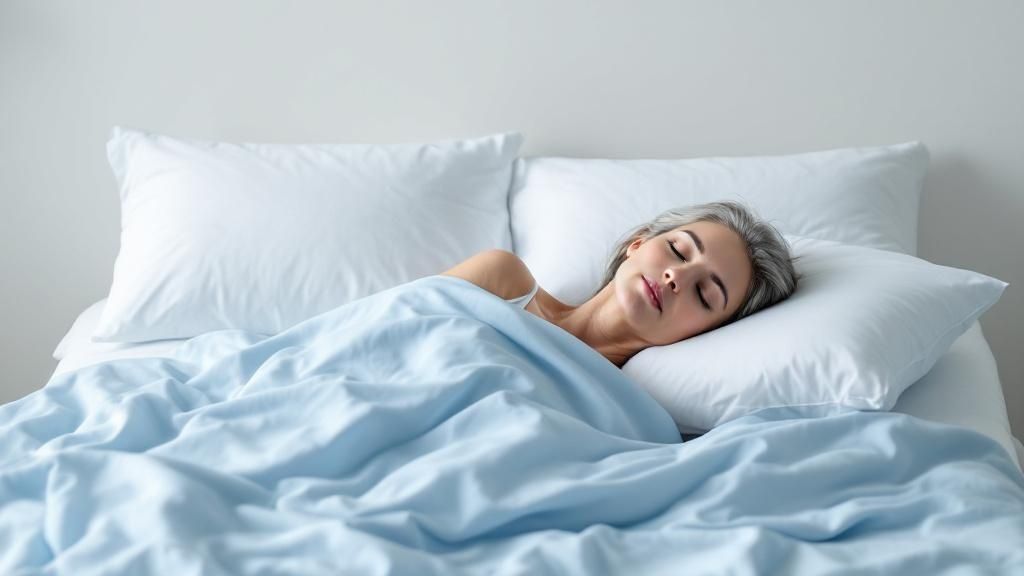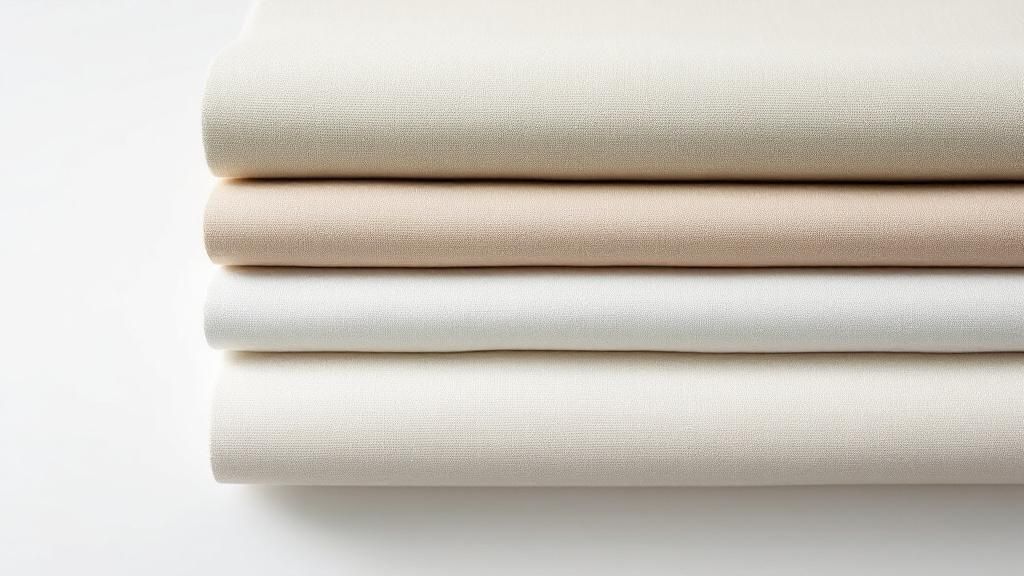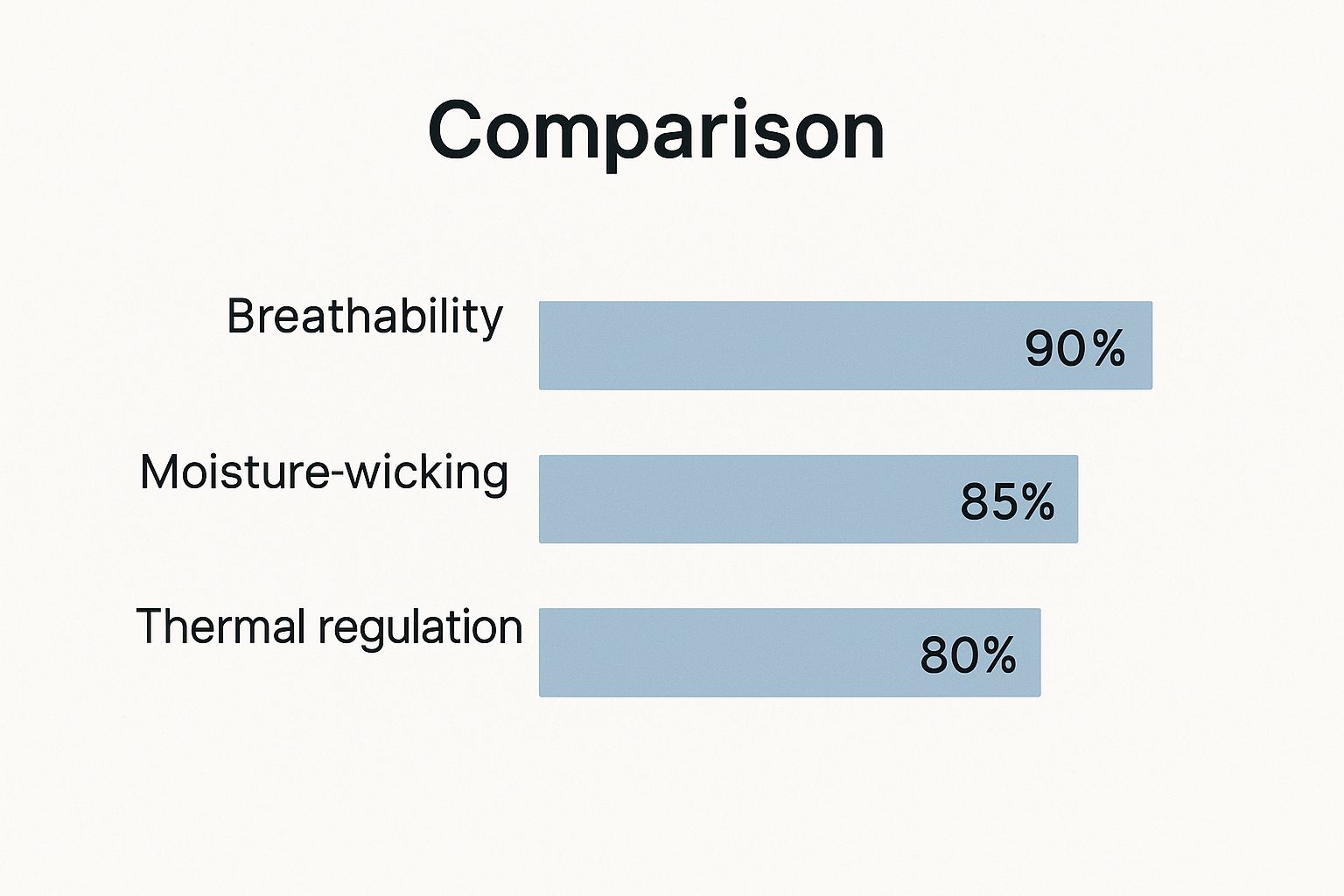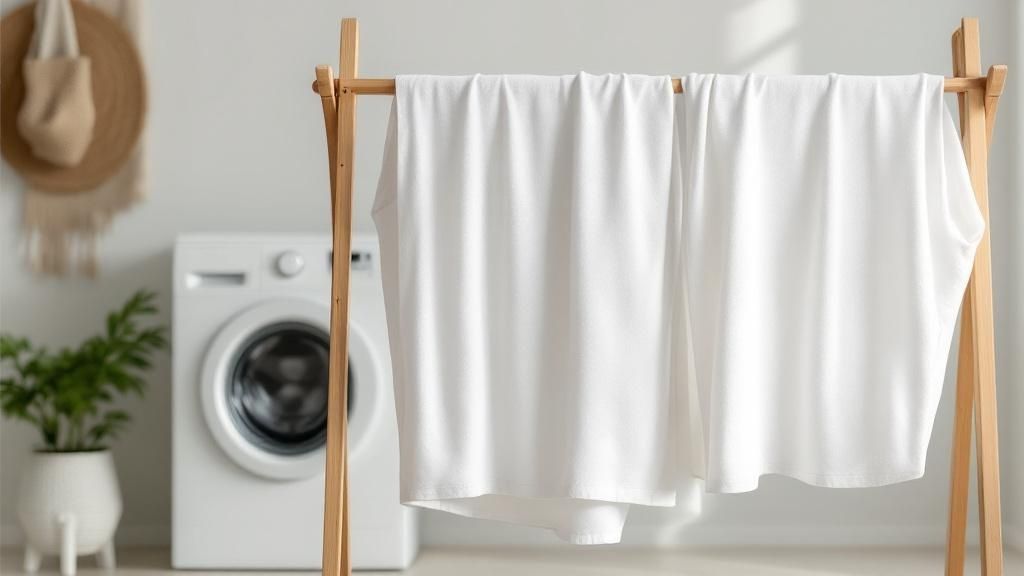If you're dealing with menopause, you already know that night sweats and hot flashes can absolutely ruin a good night's sleep. The best cooling sheets for menopause are a game-changer, and they're usually made from incredibly breathable, moisture-wicking fabrics like bamboo viscose, Tencel lyocell, or linen.
These materials are fantastic because they actively pull heat and sweat away from your body. This simple change helps manage those intense temperature swings, letting you get the comfortable, uninterrupted sleep you deserve.
Finding Relief From Menopause Night Sweats

Waking up soaked from night sweats is a deeply frustrating reality for so many women going through menopause. But the right bedding can make a massive difference. When hormonal shifts make your body's internal thermostat go haywire, you don't have to just put up with damp, uncomfortable nights. Let's cut through the marketing fluff and find you some real relief.
How Cooling Sheets Actually Work
The problem with menopausal night sweats comes down to trapped heat and moisture. When a hot flash hits, your body tries to cool itself down fast. Traditional fabrics, like heavy cotton or synthetics, just absorb that sweat and hold it against your skin, leaving you feeling clammy and cold once the flash passes.
This is where specialized bedding really shines. Cooling sheets aren't just a fancy luxury; they're a practical tool for managing your symptoms. They work on two key principles:
- Breathability: These fabrics allow air to circulate freely, preventing that stifling heat from getting trapped under the covers in the first place.
- Moisture-Wicking: They actively pull sweat away from your skin and spread it across the fabric's surface so it can evaporate quickly, keeping you dry and comfortable.
This one-two punch turns your bed from a heat trap into a cool, comfortable sanctuary. It's not about finding a magic cure, but it is about taking back control of your sleep and improving your quality of life right now.
And it's not just a niche market. The demand for these sheets is skyrocketing. The global adult cooling sheet market was valued at around USD 295.63 million and is expected to keep growing as more people look for practical ways to manage body temperature at night.
Choosing the right sheets is a proactive step toward better sleep. When you prioritize materials designed for thermal regulation, you're investing in your own well-being and tackling one of the most disruptive symptoms of menopause head-on.
While cooling sheets are a direct solution for night sweats, remember that other therapies can help, too. For instance, specialized menopause massage treatments can offer additional relief for a range of other symptoms.
Quick Guide to Top Cooling Sheet Materials
To help you choose, here's a quick rundown of the most popular and effective cooling fabrics. Each has a slightly different feel and price point, so you can find what works best for you.
| Material | Primary Benefit | Feel & Texture | Price Range |
|---|---|---|---|
| Bamboo Viscose | Superior moisture-wicking and hypoallergenic | Silky, smooth, and very soft | $$ - $$$ |
| Tencel Lyocell | Eco-friendly and exceptionally cool to the touch | Smooth, drapey, and often compared to silk | $$ - $$$$ |
| Linen | Extremely breathable and durable | Crisp, airy, and gets softer with every wash | $$$ - $$$$ |
| Percale Cotton | Lightweight and crisp | Cool, matte finish, like a classic hotel sheet | $ - $$ |
Ultimately, the best material is the one that feels most comfortable against your skin while keeping you dry all night long.
What's Really Happening During Menopausal Night Sweats?

To find the right kind of relief, it really helps to know what’s going on in your body. Menopausal night sweats aren’t just a case of feeling a bit warm—they’re intense, sudden waves of heat caused by major hormonal changes.
As you go through menopause, your estrogen levels drop. This drop messes with a part of your brain called the hypothalamus, which is basically your body's thermostat. It gets confused and thinks you're overheating, even when you're not.
So, it hits the panic button. Your body launches an all-out effort to cool down, fast. Blood vessels widen to release heat from your skin, and your sweat glands kick into high gear. That’s the hot flash and the drenching sweat that follows.
So, How Can Sheets Actually Help?
This is where your choice of bedding goes from a simple preference to a crucial part of your sleep strategy. The right sheets are designed to work with your body's sudden cool-down cycle, not against it.
Think about it: traditional cotton or flannel sheets will just trap all that heat and moisture. You end up soaked, and then once the flash passes, you're left shivering in damp, cold sheets. It's a miserable cycle.
Cooling sheets, on the other hand, are a game-changer. They specifically offer two huge benefits:
- Amazing Breathability: They let air move freely, so that blast of body heat can escape instead of getting trapped under the covers.
- Moisture-Wicking Power: They are designed to pull sweat away from your skin and help it evaporate quickly, which keeps you feeling dry.
It's good to keep in mind that while these sheets can make a world of difference for your comfort, they are treating the symptoms, not the hormonal cause. They won't stop a night sweat from happening, but they can make the experience far less disruptive to your sleep.
Understanding the why behind the sweat makes it clear that features like moisture management aren't just buzzwords; they're essential for getting a good night's rest during this phase of life. For a deeper look at different materials, our guide to the https://bamtekhome.com/blogs/bamtek-home-blogs/best-bedding-for-menopause explains why fabrics like bamboo viscose are so effective.
Comparing Cooling Fabrics and Weaves
Walking down the bedding aisle can feel overwhelming. You're hit with a barrage of terms like Tencel, Coolmax, percale, and sateen. But when you're looking for the best cooling sheets for menopause, cutting through the jargon is everything. The key is understanding the difference between the fabric itself and how it's woven together. The material is what gives the sheet its core properties, while the weave affects its texture and breathability.
You'll generally find two camps: natural fibers and high-tech synthetics. Naturals like bamboo, Tencel (which comes from eucalyptus), and linen are famous for their built-in breathability. Tencel, for instance, has a uniquely silky feel and is a champion at pulling moisture away from your skin. Linen is a whole different experience—it's crisp, airy, and has a more open structure that lets air flow freely, perfect if you just feel perpetually warm.
This visual gives a great overview of the performance metrics that really matter when choosing a cooling fabric.

As you can see, the best options score high across the board on breathability, moisture-wicking, and keeping your temperature steady—all non-negotiables for tackling night sweats.
Why The Weave Matters So Much
The material is only half the story. The way the threads are actually woven together has a massive impact on how a sheet breathes and feels against your skin. The two you’ll see most often are percale and sateen.
- Percale: This is your classic, no-fuss weave with a simple one-thread-over, one-thread-under pattern. The result is a light, crisp fabric that feels cool to the touch and breathes exceptionally well. If you love that fresh, cool feeling of hotel sheets, you’ll probably love percale.
- Sateen: This weave is a bit more complex, with a one-under, three-or-four-over pattern. It creates that buttery-smooth, silky surface with a beautiful drape. The downside? It’s not as breathable as percale and can sometimes trap heat, which might not be ideal if your night sweats are intense.
Here's a closer look at how some of the most popular materials stack up against each other.
Cooling Fabric Performance Breakdown
This table offers an in-depth look at popular materials based on the performance metrics that matter most for menopausal comfort.
| Fabric Type | Breathability Rating | Moisture-Wicking | Durability | Best For |
|---|---|---|---|---|
| Tencel/Lyocell | Excellent | Superior | Very Good | Intense night sweats and sensitive skin. |
| Bamboo Viscose | Very Good | Excellent | Good | Hot sleepers who want a silky, soft feel. |
| Linen | Superior | Good | Excellent | Those who run hot and prefer a crisp, airy feel. |
| Cotton Percale | Very Good | Moderate | Very Good | Fans of a cool, crisp "hotel sheet" texture. |
| Microfiber (Coolmax) | Good | Excellent | Good | Budget-conscious shoppers needing moisture control. |
| Cotton Sateen | Moderate | Fair | Very Good | Sleepers who prioritize softness over cooling. |
Ultimately, choosing the right material comes down to matching its strengths to your specific symptoms and preferences.
Of course, price and technology play a big role. You can find affordable sets that use Coolmax technology—a synthetic fabric known for its wicking power. On the premium end, you have materials like 100% Tencel lyocell, which offers incredible temperature regulation, with prices often ranging from $70 to $359.
The perfect sheet is deeply personal. If you experience sudden, drenching sweats, the moisture-wicking powerhouse of Tencel might be your best bet. If you just feel constantly warm, the airy, breathable structure of linen or a crisp percale weave could be the relief you need.
Getting familiar with these differences gives you the power to pick sheets that truly solve your problem. For a deeper dive, our guide to the best cooling sheets for night sweats has even more tips to help you find your perfect match.
How to Select Your Perfect Cooling Sheets

Knowing the difference between fabrics is one thing, but how do you actually pick the right set for you? Finding the best cooling sheets for menopause really comes down to understanding your own body's patterns.
Think about it: are you waking up from sudden, drenching night sweats? Or is it more of a constant, low-grade warmth that just makes you feel stuffy?
Your answer points you to the perfect material. If you're dealing with intense sweats, you need something that excels at moisture-wicking, like Tencel or bamboo viscose. But if you just run hot all the time, the incredible breathability of linen or a classic cotton percale could be exactly what you need.
Look Beyond the Thread Count
For years, we've been conditioned to believe that a higher thread count means better quality. When you're trying to stay cool, that's often a myth. A super-high thread count can actually work against you, creating a dense fabric with no room for air to flow. It basically traps your body heat.
Instead of getting hung up on that one number, shift your focus to what really matters:
- Fabric Weave: A percale weave is known for being light, crisp, and airy. It's a much cooler choice than a dense, silky sateen weave.
- Material Properties: Prioritize the fabric's natural ability to breathe and pull moisture away from your skin.
- Certifications: Look for labels that guarantee the sheets are safe and well-made.
One of the best tips I can give is to favor a breathable weave over a high thread count. A 300-thread-count percale sheet will almost always sleep cooler than a dense 800-thread-count sateen sheet.
Prioritize Health and Safety Certifications
Your skin is your body's largest organ, and hormonal changes during menopause can make it especially sensitive. This is why choosing sheets free from harsh chemicals isn't just a nice-to-have; it's crucial for getting healthy, restorative sleep.
Keep an eye out for the OEKO-TEX STANDARD 100 certification. This is a globally recognized testing system that verifies textiles are free from a long list of substances known to be harmful.
When you see that label, you can feel confident that your bedding is safe for you and your family. It's a simple, practical step that ensures the sheets you choose support your comfort, your cooling needs, and your overall well-being.
Creating a Cooler Sleep Environment
Even the absolute best cooling sheets for menopause work better when they're part of a bigger picture. I like to think of a bed as a layered ecosystem—every single component is either helping you stay cool or, unfortunately, working against you. Taking a holistic approach is what transforms a good night's sleep into a truly great one.
You'd be surprised what a few simple tweaks can do. For example, that waterproof mattress protector you're using? It's fantastic for keeping your mattress safe, but many of them are made from non-breathable materials that trap heat and moisture right where you don't want it. Switching to a breathable protector, maybe one made from Tencel or bamboo, allows your mattress to breathe and makes a huge difference.
Beyond the Sheets
Your sheets are just the start; what you wear and what you rest your head on are just as critical.
Look for pajamas made from lightweight, moisture-wicking fabrics like bamboo or modal. These materials pull sweat away from your skin instead of letting it cling to you all night. Your pillow is another heat trap, so consider a cooling pillow infused with gel or one made from shredded latex, which allows heat to escape from your head and neck.
Of course, creating a truly cool sleep haven means looking at the room itself. The ambient temperature is a massive factor. This goes beyond just cranking down the thermostat; you want to make sure your home's HVAC system is running at its best. Something as simple as regularly maintaining efficient air conditioning ducts can dramatically improve airflow and your A/C's cooling power.
A cool room, breathable bedding, and moisture-wicking sleepwear work together. When all three elements are optimized, you create a powerful defense against night sweats, allowing you to achieve deeper, more restorative sleep.
For a deeper dive into turning your entire space into a cool sanctuary, check out our guide on how to keep your bedroom cool at night.
Got Questions About Cooling Sheets? We've Got Answers
When you start looking into cooling bedding, a few practical questions always pop up. It's smart to get the facts straight before you buy, ensuring you find the right sheets to tackle those menopausal night sweats. Let's clear up some of the most common things people ask.
How Often Should I Wash My Cooling Sheets?
For peak performance, you'll want to wash your cooling sheets every one to two weeks. It might seem frequent, but body oils and sweat can clog the fabric's fibers over time, which really cuts down on their ability to breathe and wick away moisture.
Always give the care label a quick look, but my go-to advice is to wash them in cold water and skip the fabric softener. Fabric softeners are notorious for leaving a waxy film that blocks the pores of the fabric, which is the last thing you want when you're relying on them for their cooling magic.
Are Expensive Cooling Sheets Really Worth the Splurge?
Honestly, it all comes down to your personal priorities and budget. The pricier options, often made from materials like 100% Tencel Lyocell or high-quality, long-staple linen, feel incredibly soft and are built to last. They offer top-tier temperature regulation, making them a solid long-term investment in your sleep comfort.
That said, you don't have to break the bank to find relief. There are plenty of fantastic, more affordable choices out there, especially those made from bamboo blends, that do a great job of keeping you cool. The best value is always the set that feels right to you, delivers the cooling you need, and fits your budget.
It's important to remember what these sheets do. They are designed to manage the symptoms of night sweats. While they won't change the hormonal shifts causing them, they make a world of difference by pulling moisture away from your skin and keeping air flowing, so you stay comfortably dry all night.
Ready to feel the difference for yourself? Bamtek offers premium, 100% organic bamboo viscose sheets that are OEKO-TEX certified, hypoallergenic, and engineered for incredible temperature regulation. Find your ticket to a cooler, more comfortable night's sleep at Bamtek's official website.










